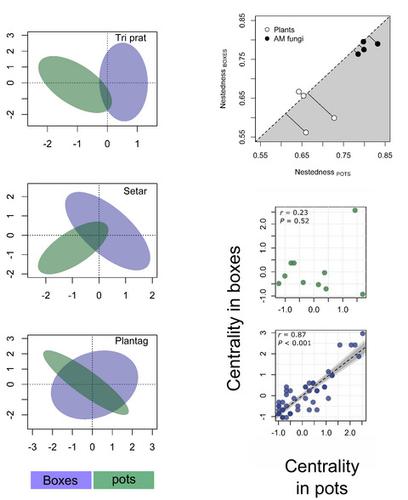Our official English website, www.x-mol.net, welcomes your
feedback! (Note: you will need to create a separate account there.)
Mycorrhizal network assembly in a community context: The presence of neighbours matters
Journal of Ecology ( IF 5.3 ) Pub Date : 2019-07-08 , DOI: 10.1111/1365-2745.13230 Pierre‐Luc Chagnon 1, 2 , Robert L. Bradley 2 , John N. Klironomos 3
中文翻译:

社区环境中的菌根网络装配:邻居的存在很重要
更新日期:2019-07-08
Journal of Ecology ( IF 5.3 ) Pub Date : 2019-07-08 , DOI: 10.1111/1365-2745.13230 Pierre‐Luc Chagnon 1, 2 , Robert L. Bradley 2 , John N. Klironomos 3
Affiliation

|
- Understanding the factors and mechanisms driving the structure of ecological networks is a challenge for community ecologists. Notably, it remains unclear whether observed interaction patterns between two trophic groups are a result of (a) preferential partner selection between groups, or (b) species interactions within groups.
- We conducted an experiment in order to disentangle these two drivers, using the plant–mycorrhizal symbiosis as a model system. We followed mycorrhizal colonization of plant roots growing either with or without neighbours. This allowed us to assess the relative importance of interaction within trophic groups (here, plant‐to‐plant interactions) on ecological network assembly.
- Results showed that plants were not equally affected by the presence of neighbours and that network nestedness was higher when plants grew without neighbours. We also found a poor correlation between the centrality (i.e., standardized number of interactions) of plant species grown in communities and those grown without neighbours, while the reverse was true for mycorrhizal fungi. This suggests that the optimum level of specificity or generalism in mycorrhizal selection is not a fixed plant trait, but a plastic, context‐dependent one.
- Synthesis. Our results show that ecological networks are not only shaped by preferential partner selection, but also by interactions within a given trophic group. This finding should be considered in future modelling exercises on ecological network dynamics. Moreover, our nestedness results suggest that in the presence of multiple host plants, mycorrhizal fungi display preferences for specific interactions, suggesting that local plant diversity may shape mycorrhizal fungal community structure.
中文翻译:

社区环境中的菌根网络装配:邻居的存在很重要
- 了解驱动生态网络结构的因素和机制是社区生态学家面临的挑战。值得注意的是,尚不清楚两个营养组之间观察到的相互作用模式是(a)组间优先伙伴选择,还是(b)组内物种相互作用的结果。
- 我们使用植物-菌根共生作为模型系统进行了一项实验,以弄清这两个驱动因素。我们跟踪了有无邻域生长的植物根的菌根定植。这使我们能够评估营养组内相互作用(在这里是植物间相互作用)对生态网络组装的相对重要性。
- 结果表明,植物没有受到邻居的同等影响,当植物在没有邻居的情况下生长时,网络嵌套度更高。我们还发现,社区中生长的植物物种与非邻域生长的植物物种的中心性(即相互作用的标准化数量)之间的相关性较弱,而菌根真菌则相反。这表明,菌根选择的最佳特异性或普遍性不是固定的植物性状,而是可塑性的,与环境有关的性状。
- 合成。我们的结果表明,生态网络不仅受到伙伴选择的影响,而且还受到给定营养群体内部相互作用的影响。在以后关于生态网络动力学的建模练习中应考虑这一发现。此外,我们的嵌套结果表明,在存在多种寄主植物的情况下,菌根真菌表现出对特定相互作用的偏好,这表明局部植物多样性可能会塑造菌根真菌的群落结构。











































 京公网安备 11010802027423号
京公网安备 11010802027423号